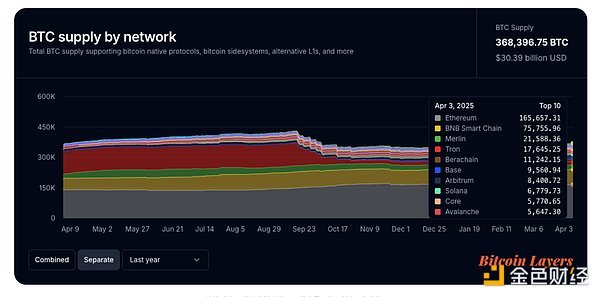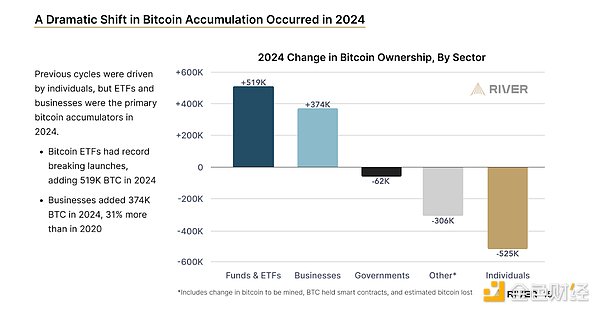Author: Jean-Paul Faraj Source: Bankless Translation: Shan Ouba, Golden Finance
For more than a decade, Bitcoin has been the cornerstone of the crypto ecosystem - praised for its decentralization, censorship resistance, and provable scarcity. However, despite its dominant market capitalization and recent resurgence in popularity, Bitcoin remains largely disconnected from one of the most active areas in the crypto space: DeFi (decentralized finance).
According to Bitcoin Layers, only about $30 billion of BTC, or just 1.875% of its total supply, is used in DeFi. In contrast, Ethereum has locked about $50 billion of ETH in DeFi, or about 23% of its supply.
This discrepancy highlights a core contradiction in today’s Bitcoin narrative: While BTC holds tremendous value, relatively little BTC is actively used on-chain toprovide yield opportunities. This gap is driving a wave of innovation around wrapping, staking, and other methods designed to bring Bitcoin into the DeFi economy and unlock ways to make BTC a productive capital asset.

Bitcoin Layers: BTC supply by network, showing all wrapped BTC
Ethereum’s DeFi ecosystem has exploded with tools for lending, staking, and trading. In contrast, productive uses of native Bitcoin remain difficult, especially for new users. Transaction speeds are slow, fees are volatile and often high, and Bitcoin’s architecture lacks the programmability to support Ethereum applications.
As the broader crypto space matures, this raises an important question: Can Bitcoin meaningfully participate in the on-chain economy? If so, how do we get average BTC holders on board without forcing them to go through bridges, wrapped tokens, and unfamiliar applications?
The Problem: Bitcoin’s Design vs. DeFi’s Utility
Bitcoin was not built for expressiveness in smart contracts as we understand it today. It prioritizes security and decentralization over expressiveness through Proof-of-Work (PoW), making it a robust store of value — but less suitable for use in smart contracts or complex DeFi applications. As a result, native Bitcoin has been largely excluded from the composable finance ecosystem that has flourished on chains like Ethereum or Solana.
Historically, there have been workarounds:
Wrapped Bitcoin: Users convert BTC to ERC-20 tokens to access Ethereum-based DeFi. This introduces custody risk, as token liquidity can be opaque and not always backed 1:1 with BTC by a third-party custodian.
Bridging Protocols: Cross-chain platforms allow BTC to be transferred to other ecosystems. But manual bridging adds friction, complexity, and risk — especially for non-technical users.
Custodial Platforms: Centralized services like Coinbase offer BTC yields but require users to give up custody, and often pay returns in points, stablecoins, or proprietary tokens rather than BTC.
Each option comes with trade-offs that challenge Bitcoin’s core ideals: security, simplicity, and user sovereignty.
Entry barriers: Why user experience still matters

Accumulation of BTC in 2024, river.com
For Bitcoin holders who are curious about how to better utilize their assets (earn yield, participate in on-chain governance, or try DeFi), the entry path remains fragmented, unintuitive, and often daunting. While the infrastructure has matured, the user experience still lags, and the competition is not just other blockchains, but also traditional finance (TradFi).
This friction creates a major barrier to entry. Most users don’t want to become sophisticated DeFi users — they want simple, secure ways to grow their net worth and BTC holdings without having to navigate a maze of applications, bridges, and protocols like most recent Bitcoin buyers who purchase off-chain through brokers, ETFs, and products like Michael Saylor’s Strategy.
To bring the next wave of users on-chain, rather than just becoming off-chain holders, tooling needs to abstract away this complexity without sacrificing control, self-custody, or transparency. This is where emerging protocols and modern wallet experiences start to really shine — providing user-friendly access to DeFi’s foundational features while keeping the core philosophy of Bitcoin intact.
A better user experience isn’t just a nice-to-have, it’s critical infrastructure for the next phase of Bitcoin adoption.
New Ways to Earn and Productivity on-Chain BTC
Many emerging solutions aim to make Bitcoin more accessible in DeFi — each with a different focus on trade-offs:
1. Staking, Restaking, and Points-Based Yield Programs
Platforms such as Babylon and Lombard now offer yield programs tied to Bitcoin through points or reward tokens, typically achieved through staking/restaking, which can often be redeemed for perks or future airdrops. These systems are attractive to early adopters and crypto natives chasing airdrops and platform-specific token economics. These products typically involve converting BTC to a wrapped BTC standard and then locking the asset in various programs/products to earn floating yield. For traders who are proficient in on-chain trading, high returns can be achieved, but this requires a deeper understanding of how to use cryptocurrencies and manually bridge, wrap and deposit funds.
Pros:
Cons:
Rewards are not paid in BTC
Often requires a lock-up period
Long-term value of rewards is uncertain
2. Bitcoin Layer 2 and Meta Protocols
Lightning Network, Rootstock (RSK), Alkanes, and emerging Layer 2s such as Botanix and Starknet 2 Networks are bringing new functionality, programmability, and speed to Bitcoin. These innovations enable use cases like fast payments, NFTs, and smart contract-like behavior. As a result, users can now use their BTC to access a variety of DeFi opportunities — such as securing the network by locking up funds, participating in market making, lending, or converting assets to support the Wrapped BTC standard on various protocols. As more teams build these networks, the ecosystem of yield opportunities based on Bitcoin will continue to expand.
Advantages:
Expands Bitcoin’s use cases
Aligns with Bitcoin’s architecture
Various ways to earn income on-chain
Disadvantages:
Still in a relatively early stage and fragmented
Requires intermediate to advanced understanding to use
Requires significant developer resources to build on most of the functionality that already exists on other smart contract chains
3. Smart Wallet Integration and Native BTC Yield
Wallets like Braavos (disclaimer: I work here!) offer functionality that allows users to earn native BTC yield without having to manually wrap their Bitcoin or give up custody. Users can invest BTC directly through their wallets without having to deal with the usual hurdles of bridging or using external applications. Complex steps — such as depositing, wrapping, and bridging — are seamlessly handled in the background, and BTC is deployed into specific DeFi strategies. This user-friendly approach is designed to make BTC yield accessible to everyone, regardless of technical background or cryptocurrency experience.
Pros:
Cons:
The Macro Perspective: Bitcoin’s Evolving Role on-chain
Bitcoin’s narrative has long revolved around “store of value” — a role it fulfills reliably. But as the on-chain economy grows, pressure is growing for Bitcoin to integrate into this emerging financial system and fulfill its promise as a reliable payments infrastructure.
To do this without sacrificing decentralization or user trust, new infrastructure must make these opportunities easily accessible without requiring technical expertise or abandoning Bitcoin’s core principles.
This means:
Yields should be paid in BTC in preference to derivative assets
Custody must remain with the user
Complexity must be abstracted away, not shifted to the user
Braavos, Lombard, Babylon, and the other products mentioned in this article are examples of how these ideas are being implemented. Whether by enabling users to earn yield through staking, or by embedding Bitcoin support directly into self-custody options and automating the complexity behind it, they are making DeFi more accessible to Bitcoin holders — without requiring them to leave the Bitcoin ecosystem entirely.
Carefully Bridging the Gap
Bitcoin’s transition to an on-chain economy won’t happen overnight — and nor should it. Caution, simplicity, and self-sovereignty are fundamental to Bitcoin’s philosophy. But BTC’s role in the broader cryptoeconomy is evolving as more tools emerge that respect those values and offer new capabilities.
The challenge now is to build systems that are open, secure, and most importantly — accessible. If the next billion users are to be onboarded through Bitcoin, they will need experiences that meet their existing needs and can be adopted by the broader user base.
 Alex
Alex
 Alex
Alex Catherine
Catherine Miyuki
Miyuki Kikyo
Kikyo Anais
Anais Catherine
Catherine Weatherly
Weatherly Kikyo
Kikyo Alex
Alex Weatherly
Weatherly